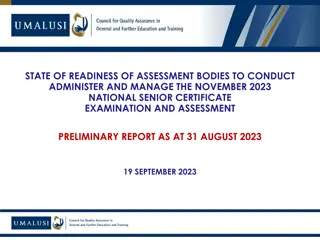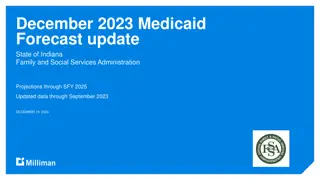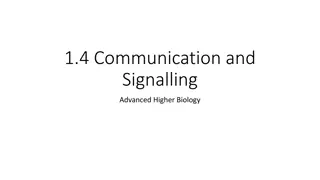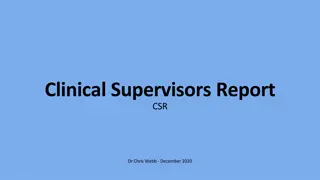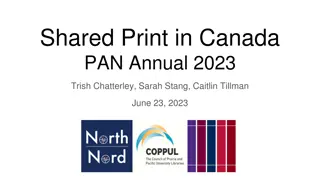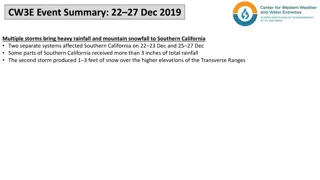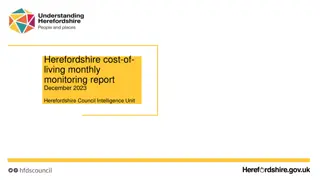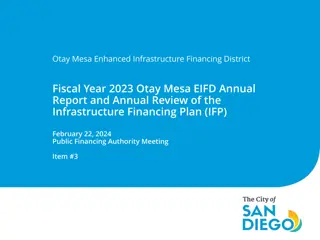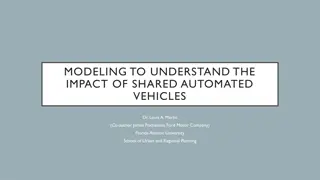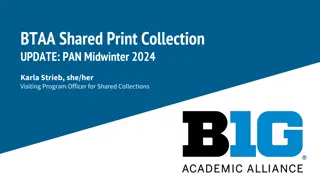Signalling Shared Learning Report - December 2023
This report highlights key incidents and learnings from Signalling Projects between July 2023 and December 2023. It emphasizes the importance of safety measures to prioritize passenger well-being. The 35th-anniversary reflection on the Clapham Disaster serves as a stark reminder of the consequences of negligence in railway operations. Issues such as crossed wires and TPWS intervention underscore the need for stringent adherence to protocols and continuous training for railway staff to ensure passenger safety remains paramount.
Download Presentation

Please find below an Image/Link to download the presentation.
The content on the website is provided AS IS for your information and personal use only. It may not be sold, licensed, or shared on other websites without obtaining consent from the author.If you encounter any issues during the download, it is possible that the publisher has removed the file from their server.
You are allowed to download the files provided on this website for personal or commercial use, subject to the condition that they are used lawfully. All files are the property of their respective owners.
The content on the website is provided AS IS for your information and personal use only. It may not be sold, licensed, or shared on other websites without obtaining consent from the author.
E N D
Presentation Transcript
OFFICIAL Signalling Shared Learning Engineering Services Delivery Issue 02 - December 2023 Putting passengers first
OFFICIAL Introduction This Signalling Shared Learning details various events and incidents that have occurred on Signalling Projects between July 2023 and December 2023, and provides the key learning points associated with them. It is intended for distribution within the Network Rail Signalling community and the wider Supply Chain in order to raise awareness of the learning points within, and to enable best practice to be applied throughout all of our signalling activities. Putting passengers first 2
OFFICIAL 35th anniversary of the Clapham Disaster Background December 2023 marks the 35th anniversary of the Clapham Rail Disaster, where 35 passengers and train crew lost their lives. 484 were injured. The disaster was caused by a single, loose and uninsulated stray wire. This resulted in a relay energising, allowing a signal to display a green aspect when it should have been red. The result was a rear end collision between two trains, with a third train on the adjacent line colliding with the subsequent wreckage. Key Learning We must remember these historic incidents and the key learning associated with them. Many of our industry s rules, procedures, standards and practices of today are as a direct result of previous incidents and the learning from them, so a repeat can be avoided. There is a real risk of corporate memory loss , of this and other accidents and the collective forgetting of what we must do, and why we do it. Putting passengers first 3
OFFICIAL SMTH crossed wires Background After a track renewal project, previously disconnected signal and track circuit cables were reconnected and tested using the Signal Maintenance Testing Handbook (SMTH). One of the first trains the following morning reported receiving a red aspect following green aspects, where a yellow was expected. This train SPADed the red signal and came to a stand. A 2nd following train then received a yellow aspect instead of the red expected, and narrowly avoided a rear end collision with the first train, only because of the actions of the train driver and the signaller. Key Learning This incident is one of several SMTH irregularities recently experienced. All staff, particularly SMTH testers, are reminded of the importance of carrying out SMTH fully and correctly, and of the independence required between installation and test. Non-technical skills training is available, including a module on conscientiousness. Putting passengers first 4
OFFICIAL TPWS Intervention Background A train driver report a TPWS activation on approach to a buffer stop, set at 10mph. Following local S&T Technician investigation, the TPWS loops were found to be 5.5m apart, rather than the 4.5m shown on the signalling plan. Following loop replacement at 4.5m as per the drawings, two further trains also reported TPWS activations. Unbeknownst to the technicians, in response to several historic reset and go and unwarranted TPWS interventions, in 2006 a TPWS Optimisation Project undertook analysis and stakeholder consultation that led to the use of 5.5m spacing for Buffer Stop TPWS; this change applied to all new installations and was also applied to all existing installations. To aid efficient delivery of this campaign change, a slimmed down process was adopted that did not include updating of records and plans that had already been returned to NRG following the initial fitments. Key Learning Projects should be aware of this potential for drawing deficiency, and are reminded that other drawing discrepancies and correlation errors may also be present in records and drawings, particularly where standards have changed since the original equipment was installed. A Notice Board is forthcoming to further publicise this issue. This incident is also a further example of corporate memory loss and the potential consequences of this. Putting passengers first 5
OFFICIAL Cable ties on gantry Background Multiple signal cables fell from a signal gantry onto the OHLE below, causing considerable damage to a signalling location case. The cable tray was mounted vertically, conflicting with current standards, but allowed at time of installation. A similar incident occurred in January 2020, included in Shared Learning SL22. Key Learning NR/SP/SIG/19812 Cross Track Cable Management and NR/BS/LI/424 state: New cabling shall not be attached to d) a cable tray or containment system using cable ties or fixings that are susceptible to degradation from heat, moisture and ultraviolet radiation within the design life of the system. Projects are reminded they are to install cables on gantries and other structures in line with this guidance, using an approved method of securement. Putting passengers first 6
OFFICIAL Signaller Reminder on ARS Workstation Background An existing SSI interlocking had been altered several times over the previous ten years, as part of various signalling interventions and re-controls. During this period, some non-safety critical functions were implemented in the Control System environment, rather than the interlocking. The signaller at a ROC workstation reported an occurrence that with Signaller reminder applied on a particular signal, the Automatic Route Setting (ARS) system signalled a train through the signal to the next section. This signal had been altered as part of previous works to enable ARS. Data to perform Signaller Reminder applied check on ARS requested routes had been omitted from the system wide application for signals in the interlocking area. No check of the Signaller Reminder Applied function was performed by the signalling and control system when ARS made the route request. Key Learning Close attention should be paid to legacy systems where controls may not be as expected, and where assumptions may cause issues that are not immediately visible. Over recent years there has been an increase in controls deemed non-safety critical being moved from the interlocking to the control system. As the controls can reside in either system it is important that the location and responsibility is identified, understood and documented. If required, clarification is to be sought from the Infrastructure Manager. Formalise all decision making, especially where transferring responsibility and seek confirmation of actions being allocated, actioned and closed. Putting passengers first 7
OFFICIAL LED Route Indicators- Terminal Allocation Background There is no standard convention for the assignment of indication circuit wires to the terminal block in the Miniature and Standard LED Indicator enclosure. Terminals are assigned in the location design; but this may not be issued to the supplier. A signal was provided with a SARI which initially had four route indications and the design was issued for factory construction. Subsequently, a design modification was issued to modify a Platform 2 route indication to 2D and 2U ; as the same destination can be approached via two different routes. The route indication arrangements were communicated to the supplier; however, the issued design required to be modified on site to match the route indicator internal wiring. Key Learning Projects and designers are asked to adopt the convention that terminals are numbered in the indications in alphanumerical order, i.e. Alphabetical (A to Z); then, Numerical (0 to 9); then, Alphanumerical (A1 to Z9) Numeric-alphabetical (1A to 9Z) Projects must be aware of this hazard and ensure that indications correlate to the wiring at the pre-testing stage, by illuminating the aspects at a suitable and safe time. Putting passengers first 8
OFFICIAL Further Information For any further details or information regarding any of the incidents, please contact: Chris Ruddy: Senior Engineer Engineering Services Delivery, Route Services Tel: 07799 336772 email: christopher.ruddy@networkrail.co.uk Putting passengers first 9


















